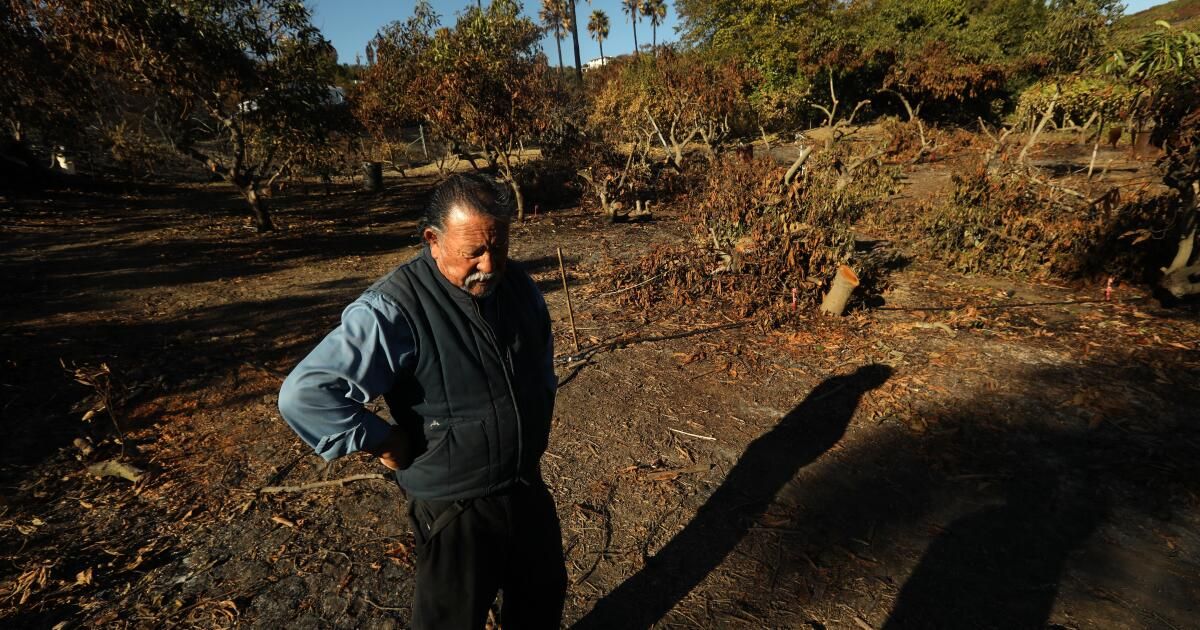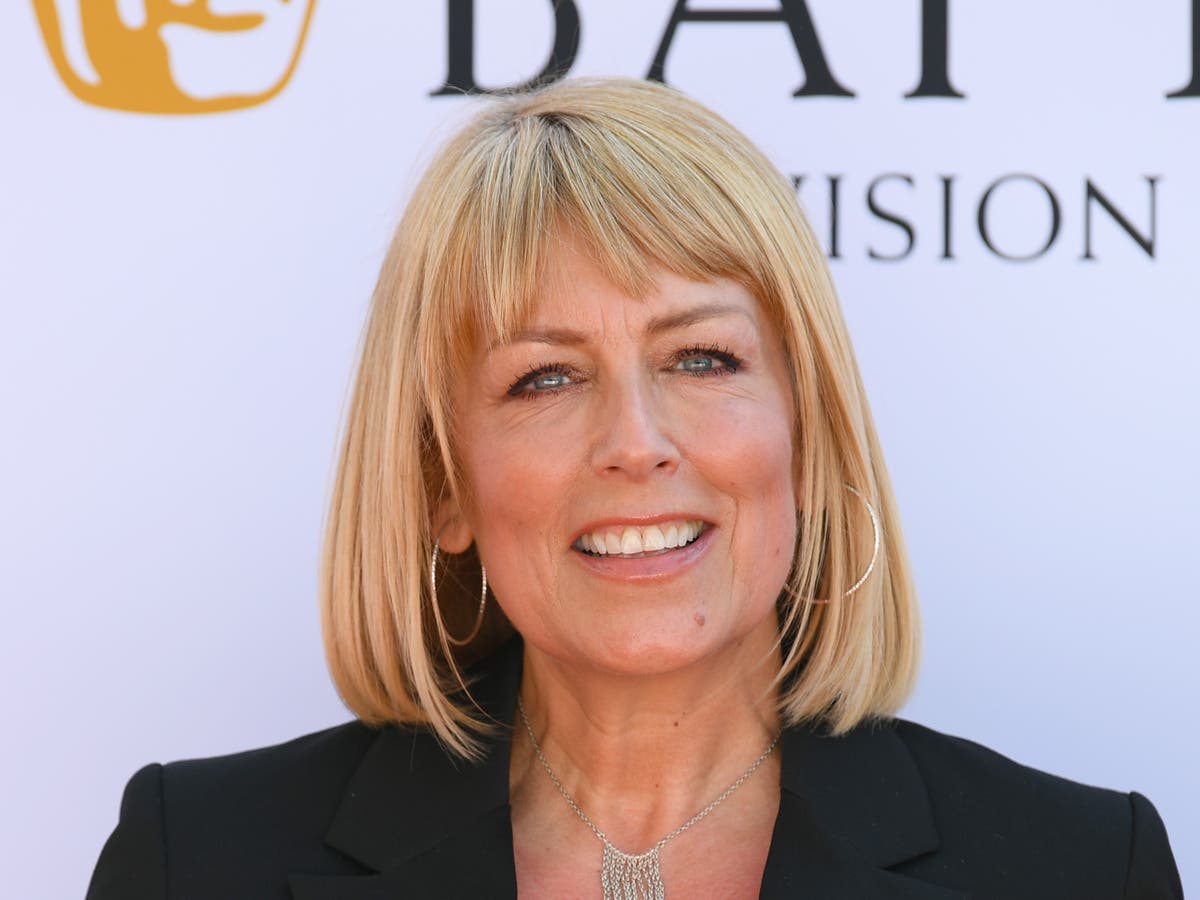SOMIS— Thousands of Hass avocados scattered the soil of Sergio Acevedo's orchard in this community northeast of Camarillo on Saturday. The mountain fire had burned some of the fruit, leaving it shriveled or reduced to ashes.
But the fierce winds that followed the fire swept through the area and ripped more than half of the remaining avocados from the trees, scattering them across their two-acre farm. Most of the fruit on the ground seemed intact: bright green and good enough to eat.
But Acevedo knew better. He picked one up from the ground and cut a slice to reveal the inside: dry and dull green.
Sergio Acevedo shows a ruined avocado that has lost all its moisture and can no longer be eaten.
“You see? There's no oil. It's not ready,” he told his daughter Wendy Acevedo. “But it was very close.”
The avocados were only a month away from being ripe enough for the market. The 75-year-old man shook his head and threw the ruined fruit onto the ground. Over the weekend, Acevedo and his family surveyed their land, where the fire had damaged or destroyed approximately 100 of their 300 avocado trees. Acevedo's orchard is one of more than 140 avocado farms in the burned area, according to Ventura County Agriculture Commissioner Korinne Bell.
The county is the state's top producer of avocados, he said.
Most of the avocado growers in the area burned by the Mountain fire are small farmers, Bell said: “They have a small couple [of] acres here or there.”
As of last week, the Mountain Fire had burned 12,000 acres of agricultural land. Avocados were among the most affected crops.

Acevedo removes the branch of an avocado destroyed by the Mountain fire. The fire damaged or destroyed about 100 of its 300 avocado trees.
So far, 4,102 acres of avocados were in the burned area, representing a quarter of the 16,497 acres of avocados harvested in Ventura County last year. However, it is too early to know exactly how many avocado trees in the area were damaged or destroyed, Bell said.
County officials completed a quarter of their study and counted 588 acres of avocado that were damaged or destroyed during the fire. Losses are estimated at $4.3 million.
“We expect that number to increase a lot,” Bell said.
It's not yet clear whether the avocado market will be affected by the fire, because most of the harvest starts in winter and runs into summer in Ventura County, he said. “So if there are market impacts, we won't see them until then.”
For now, consumers are unlikely to see an increase in the price of avocados due to the fire because most avocados purchased in the United States are imported from Mexico.
In total, more than 240 structures, many of them primary residences, were destroyed and 127 damaged during the Mountain Fire. As of Wednesday, the nearly 20,000-acre fire was 98% contained.
The current crop is almost gone

The farmer gives his granddaughter, Maya Solís, 14, a hug as his daughter Wendy Acevedo Solís watches from the family's fire-damaged avocado farm in Somis.
Acevedo said he felt bad for the many who lost their homes in the fire. He lives in Oxnard with his wife and has never built a house on his farm. But it hurt him to see how the fire had burned the trees he had so lovingly cared for for almost 25 years.
The fire also destroyed their irrigation system. He didn't have fire insurance, he said.
In the first days after the fire, Acevedo said, he was devastated by the images of destruction he saw. But a few days later, he began to focus on moving forward. Wendy, 43, started a GoFundMe for him. At first his father opposed it. He's still a little undecided.
“You are always helping other people. “It's time for you to accept help too,” he told her as they walked through the damaged orchard.
He has recalled his beginnings as an immigrant farmer who came to the United States and started with almost nothing. He had only $100 in his pocket when he left Mexico City for the United States in the 1970s, he said. From there, she bought a house, sent her two children to college, and put a down payment on her daughter's house.
In 2003, Acevedo invested most of his retirement money to buy the avocado orchard where he also grows some other fruits such as tangerines, custard apples and pomegranates. After years of spending every free minute on the farm, his garden became productive and profitable enough to stand on its own.

Avocados that are no longer good to eat due to damage from the Mountain Fire.
The farm was not just an investment, it became his refuge.
It was the scene of so many family memories, life milestones and new traditions. It's where he taught his son, now an adult, to drive. It was where his daughter got married 16 years ago, among mandarin and orange trees that he had just planted. And it's where her granddaughters plant pumpkin seeds in the spring and pick pumpkins in the fall.
During the week he works as a diesel mechanic for an agricultural company and spends most of the weekend in the garden. He had hoped to retire on the farm, but now that seems like a tougher proposition.
“Nothing is impossible,” he said. “You just have to work hard. I just need to start over.”
He said he tries to see the fire as a setback, but not the end. It takes three years for an avocado sapling to begin producing fruit and about five years to produce a full yield. Acevedo will have to wait until February to grow his next saplings, all of them Hass, the main variety grown in California.
But first you'll need to prepare the ground, including cutting dead trees down to the stump, removing their roots, and removing everything from your property. It will take at least $20,000 just to do that, and that's not counting the near-total loss of this year's crop, he said.
Acevedo said it will likely be in the red for a few years before breaking even. Wendy said she helped her father apply for financial assistance with the U.S. Department of Agriculture.

“It is not the end of life. It's coming back,” said avocado grower Sergio Acevedo, 75, who plans to plant new trees on his farm in Somis.
On Saturday, Acevedo, an agile and lively senior, moved quickly to inspect the orchard. Several trees were completely charred. Some had fallen. Others seemed parched, but only had a few avocados left. Then there were a bunch of vibrant green trees, which were saved from hell.
He approached a navel orange tree that had some charred branches. He picked up a freshly fallen orange and took a knife from his pocket to cut it in half. Acevedo peeled off some of the skin and took a big bite.
“It's still sweet,” he said. “This tree, this one, will be fine.”












